The successor to the famous Hubble Space Telescope, the James Webb Space Telescope was developed by the U.S. and Canada and launched at the end of last year. The recently released first observation images show us a detailed view of deep space, which is simply breathtaking, and creates anticipation about the scale of results to come.
At the White House on July 11, President Biden unveiled the first image, remarking that "These images are going to remind the world that America can do big things, and remind the American people - especially our children - that there's nothing beyond our capacity. We can see possibilities no one has ever seen before. We can go places no one has ever gone before."
"This is a singular and historic moment," said Thomas Zurbuchen, associate administrator for the National Aeronautics and Space Administration (NASA)'s Science Mission Directorate. Mr. Zurbuchen praised the development team, further commenting that "It took decades of drive and perseverance to get us here. These first images show us how much we can accomplish when we come together behind a shared goal, to solve the cosmic mysteries that connect us all."
The James Webb Space Telescope was developed as the successor to the Hubble Space Telescope, which the U.S. launched in 1990. The Webb telescope features a 6.5 meter diameter primary mirror, which is significantly larger than the Hubble's 2.4 meter instrument. It also has an enormous sun shield measuring 21 meters in length and 14 meters in width to keep the instruments at low temperatures, and a total payload mass of 6.2 tons. The Telescope is named after James E. Webb (1906-1992), NASA's second administrator. In contrast to the Hubble, which mostly observes light at optical wavelengths, the Webb specializes in near-infrared and mid-infrared rays.
Launched on December 25 last year
The Webb telescope took about one month to travel the 1 million miles (1.5 million km) to the second Lagrange (L2) point. Here, the gravitational forces of the Sun and the Earth are in balance, and the Webb will conduct its observations. During the trip, the Webb's intricately packed instruments were fully deployed, its systems checked, and telescope carefully adjusted. After further adjustments, NASA released observation images such as the following, on July 11 and 12, right on schedule. These images are synthesized from infrared images of differing wavelengths, with likely colors added.
The Landscape of Star Birth: NGC 3324
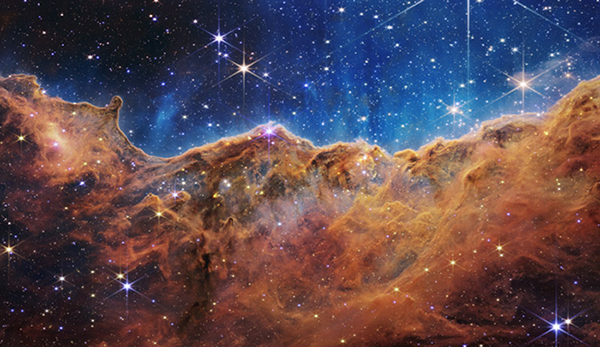
(provided by NASA, the European Space Agency (ESA), the Canadian Space Agency (CSA), and the Space Telescope Science Institute)
The image shows part of the "NGC 3324" region in the Carina Nebula, an area located roughly 7,600 light-years away where many stars are formed. What look like mountains and valleys in the image are known as "Cosmic Cliffs." The upper part of the image includes numerous massive, young stars, which emit intense radiation and gas, carving away at the molecular clouds.
Do you enjoy dancing? Stephan's Quintet
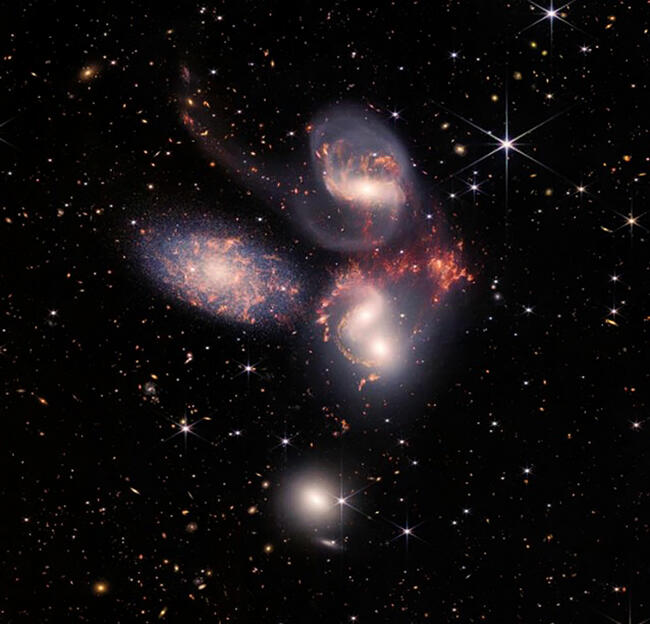
(provided by NASA, the European Space Agency (ESA), the Canadian Space Agency (CSA), and the Space Telescope Science Institute)
Located in the Pegasus constellation, Stephan's Quintet is a group of five galaxies. Although called a quintet, appearances can be deceiving. Only four of the galaxies are truly close to each other, located about 290 million light-years from Earth. The fifth and leftmost galaxy - called NGC 7320 - is well in the foreground, located around 40 million light-years from Earth. NASA describes the four as "caught up in a cosmic dance," making them an important subject of observation to research how galaxies interact. At the center of the topmost galaxy - NGC 7319 - is a supermassive black hole 24 million times the mass of the Sun.
The Shape of a Dying Star: The Southern Ring Nebula
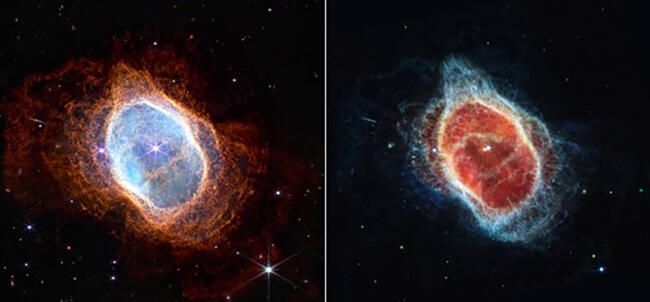
(provided by NASA, the European Space Agency (ESA), the Canadian Space Agency (CSA), and the Space Telescope Science Institute)
Images of NGC 3132, a planetary nebula in the Vela constellation approximately 2,500 light-years away, were captured using two cameras with different wavelengths. The way the dying star at the center of this scene sends out gas and dust leads the nebula to also be known as the Southern Ring Nebula. The James Webb Space Telescope has demonstrated that this star is cloaked in dust.
A Gravitational Lens Bringing Together the History of Space: SMACS 0723
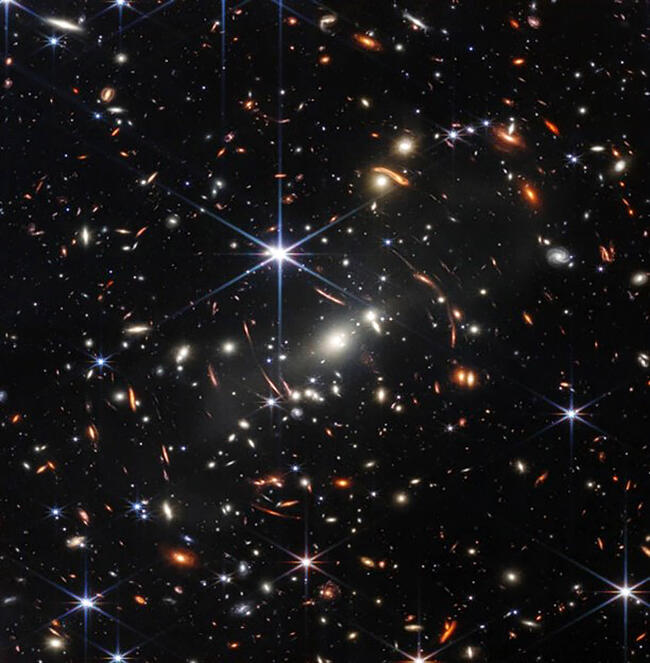
(provided by NASA, the European Space Agency (ESA), the Canadian Space Agency (CSA), and the Space Telescope Science Institute)
SMACS 0723 is a cluster of galaxies near the Volans constellation, around 4.6 billion light-years away. President Biden unveiled this image in person, the first image publicly revealed from the James Webb Space Telescope. The enormous mass of this galaxy cluster in the center of the image acts as a gravitational lens, bending the light rays from the countless galaxies beyond it and including them around this cluster. It is believed that some are as far as 13.1 billion light-years away. The images are significantly more distinct than those from the Hubble Space Telescope.
In addition, detailed atmospheric observation data was released about the WASP-96 b exoplanet, located roughly 1,150 light-years away in the Phoenix constellation.
These images really only form a teaser, inviting us to "watch this space." Expectations for the Webb telescope are very high; for example, it aims to observe galaxies and stars a mere 200 million years after the birth of the universe 13.8 billion years ago and unlock the history of space. It will also search for the possible birth of exoplanets. Since the 1990s, 5,060 exoplanets have been discovered as of July 19. Finding among them planets similar to the Earth with atmospheric constituents possibly including oxygen and methane - the building blocks of life - would be an epoch-making achievement. Commenting on these images, Greg Robinson, Webb program director at NASA Headquarters, said that "We are elated to celebrate this extraordinary day with the world. The beautiful diversity and incredible detail of the Webb telescope's images and data will have a profound impact on our understanding of the universe and inspire us to dream big."
The complex structure of the James Webb Space Telescope meant that its development encountered many difficulties, with launch being delayed by a total of 14 years. Development costs, which were estimated in the mid-1990s to be 500 million-1 billion U.S. dollars, ultimately soared to 10 billion dollars (1.38 trillion Japanese yen). At one time, calls to suspend the program were growing in intensity, and doubts were growing among scientists about whether the program would actually come to fruition.
Although I (the author) have written articles describing the Webb in glowing terms, such as comparing its shape to that of a "space sailboat," I have also felt that it was a "ghost telescope" that may never come to be as a result of the doubts expressed about it. Upon glimpsing these images, I was absolutely thrilled, shouting "they actually did it!" There is likely to be room for improvement in how the project has been pursued, but I would like to take the opportunity to congratulate the project team for their tenacity and success. I also hope that the Webb Space Telescope makes a positive impact, such that it becomes a household name, just like the Hubble did.
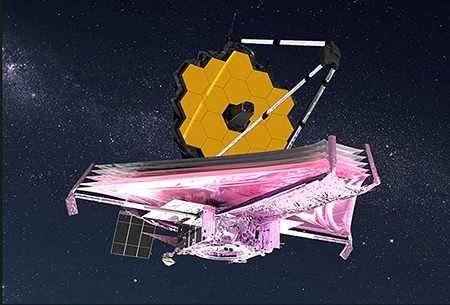
(provided by NASA)
KUSAKA Takeo / Science Portal Editorial Office
Original article was provided by the Science Portal and has been translated by Science Japan.




